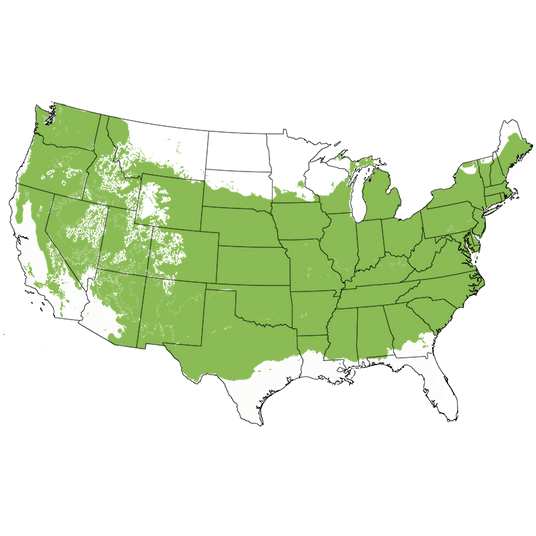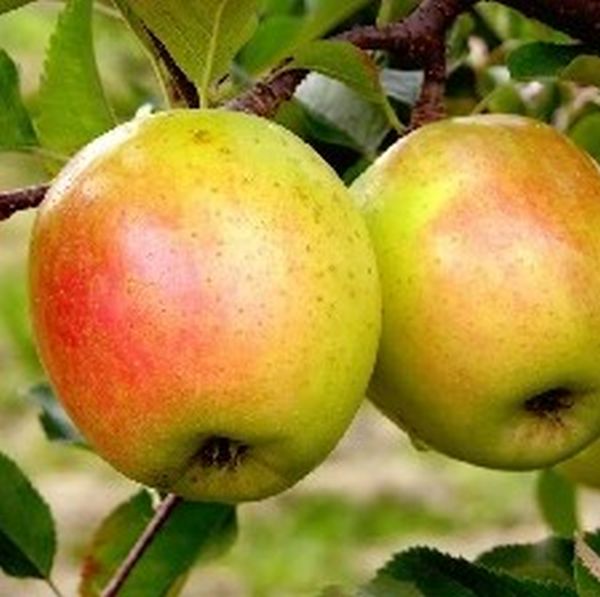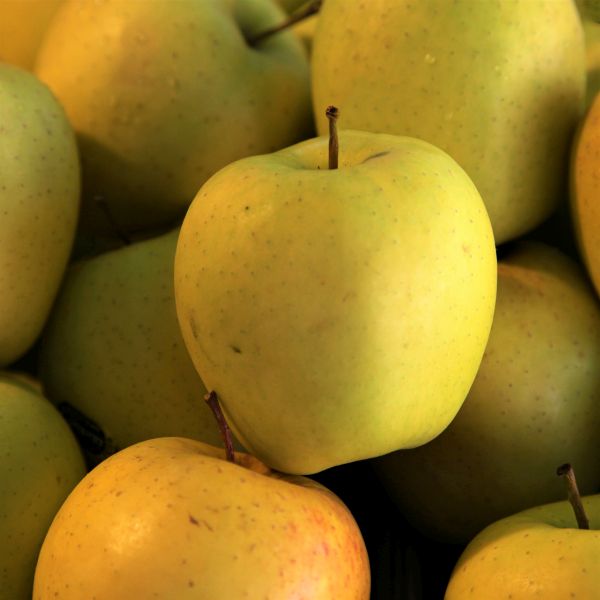GoldRush Apple Tree
Malus 'Co-op 38'
Plant Sentry™
Plant Sentry™

Plant Sentry™ Protected
Your order is protected by our compliance system that:
- Prevents restricted plants from shipping to your state
- Ensures plants meet your state's agricultural requirements
- Protects gardens from invasive pests and diseases
Delivery and Shipping
Delivery and Shipping
Delivery and Shipping
Fast, Safe Plant Delivery
Ships in 3-4 business days • Tracking provided • Weather protected
| Under $50 | $9.99 |
| $50 - $99.99 | $14.99 |
| $100 - $149.99 | $16.99 |
| $150 - $198.99 | $24.99 |
| $199+ | FREE |
✓ Zone-specific timing • ✓ Professional packaging • ✓ Health guarantee
Understanding Plant Options
Nature Hills offers plants in two main formats:
- Container Plants: Grown in pots with soil, sized by container volume and plant age
- Bare Root Plants: Dormant plants without soil, sized by height measurements
Container Plant Sizes
Container sizes indicate plant age and growing capacity rather than liquid volume equivalents. Our containers follow industry-standard nursery "trade gallon" specifications, which differ from standard liquid gallon measurements.
Young Plants (6 months to 18 months old)
| Container Size | Actual Volume | Metric Equivalent |
|---|---|---|
| 2" x 2" x 3" | 0.18 - 0.21 dry quarts | 0.20 - 0.23 dry liters |
| 4" Container | 0.31 - 0.87 dry quarts | 0.35 - 0.96 dry liters |
| 4.5" Container | 0.65 dry quarts | 0.72 dry liters |
| 6" Container | 1.4 dry quarts | 1.59 dry liters |
| 1 Quart | 1 dry quart | 1.1 dry liters |
| 5.5" Container | 1.89 dry quarts | 2.08 dry liters |
Established Plants (18 months to 2.5 years old)
| Container Size | Actual Volume | Metric Equivalent |
|---|---|---|
| 2 Quart | 2 dry quarts | 2.2 dry liters |
| #1 Container | 2.26 - 3.73 dry quarts | 2.49 - 4.11 dry liters |
| 5" x 5" x 12" | 3.5 - 4.3 dry quarts | 3.85 - 4.74 dry liters |
Mature Plants (2-4 years old)
| Container Size | Actual Volume | Metric Equivalent |
|---|---|---|
| #2 Container | 1.19 - 1.76 dry gallons | 5.24 - 7.75 dry liters |
| #3 Container | 2.15 - 2.76 dry gallons | 8.14 - 12.16 dry liters |
Large Plants (3-5 years old)
| Container Size | Actual Volume | Metric Equivalent |
|---|---|---|
| #5 Container | 2.92 - 4.62 dry gallons | 12.86 - 20.35 dry liters |
| #6 Container | 5.25 - 6.01 dry gallons | 23.12 - 26.42 dry liters |
| #7 Container | 5.98 - 6.53 dry gallons | 26.34 - 28.76 dry liters |
Bare Root Plants
Bare root plants are sold by height from the root system to the top of the plant. Plants may exceed minimum height requirements.
Common Sizes:
- Trees: 1 foot, 2 feet, 3 feet, 4 feet, 5 feet, 6 feet
- Shrubs & Perennials: 1 foot, 18 inches, 2 feet
Important Notes
Container Volume Specifications
- Trade Gallon Standard: Our containers follow industry-standard "trade gallon" specifications established by the American National Standards Institute (ANSI Z60.1) for nursery stock
- Volume Variations: Actual soil volume may vary due to plant root systems and growing medium settlement
- Age Indicators: Container size primarily indicates plant age and maturity rather than liquid volume equivalents
Growing Conditions
- Plant size can vary based on variety and growing conditions
- Container size helps indicate plant maturity and establishment level
- Larger containers generally mean more established root systems and faster landscape establishment
Seasonal Availability
- Bare root plants are available seasonally when dormant
- Container plants are available throughout the growing season
- Specific varieties may have limited availability in certain sizes
Questions?
For questions about specific plant sizes or availability, please contact our plant experts who can help you choose the right size for your landscape needs.

Plant Sentry™ Protected
Your order is protected by our compliance system that:
- Prevents restricted plants from shipping to your state
- Ensures plants meet your state's agricultural requirements
- Protects gardens from invasive pests and diseases
Plant Profile & Growing Essentials
Cold hardy, Disease resistant, Flowering, Edible, Ornamental Berries/Fruit, Thornless, and Attracts pollinators
Specifications
Specifications
-
Botanical Name
-
Height
-
Width
-
Growing Zones
-
Sunlight
-
Growth RateModerate
-
Flower Color
-
Leaf Color
-
Pollinator FriendlyYes
-
Pollinator Required
-
Harvest Time
-
FragrantYes
-
Bloom PeriodLate Spring
Planting & Care Instructions
Planting & Care Instructions
The King of Keepers Yellow GoldRush Apple
- Late Season
- Bronze-Blushed Yellow Apple
- Light, Snappy and Very Juicy
- Fresh Eating, Baking and Cider
- Sweet-Tart Flavor Grows Even Sweeter in Storage
- Extremely Valuable Keeper, Stores Up to 8 Months in Refrigerator
- Pretty White, Fragrant Blossoms in Spring
- Shows Resistance to Apple Scab, Mildew and Fire Blight
- Handles Pruning Well, Can Be Kept Smaller
You’re on the hunt for the perfect new Apple tree for your backyard orchard. Your standards are high. Star qualities include flavor, productivity, long storage life, disease resistance, and showy flowering.
GoldRush Apple (Malus 'Co-op 38') is well worth weighing as an invaluable selection for growing apples at home. It bears delicious sweet and spicy fruit that is useful for both fresh eating, baking and cider.
This tree is a great value. You’ll be so pleased at how quickly the precocious young trees produce a lush fruit set of apples. As you might imagine, the complex, spicy taste hits you in a "rush" of flavor.
Some say it's like a classic Golden Delicious with hints of pear, spice, and citrus. Doesn't that make your mouth water?
This improved selection also shows wonderful resistance to disease, including fire blight and powdery mildew and the dreaded apple scab. It’s a minor chore to prune in late winter to keep them smaller for easier harvest.
Best of all, GoldRush bears fruit that stands up to a long storage season. You’ll make it through the winter with GoldRush kept at proper refrigeration.
They can keep for up to a year in your refrigerator crisper and still taste super fresh. You read that right - pick one in the fall and still enjoy it a year later!
It’s amazing how the flavor changes through the storage season. It’s like a well-aged bottle of wine that deepens and mellows in flavor as time goes on. Thankfully, the texture stays nice and crisp.
It is great for hot apple crisp in the coldest, darkest months of the year. It has as refreshingly crisp a bite at Easter as it did at Thanksgiving.
People across the United States are adding fruiting trees to their landscape. GoldRush Apple effortlessly extends your storage season. You won't believe how good these snappy, fine-textured apples taste, even after months in the fridge.
If you only have room for a couple of Apple trees, make sure you go for a GoldRush Apple tree.Order yours today, as these will sell out quickly!
How to Use GoldRush Apple Tree in the Landscape
Modern fruit lovers are including several varieties in "high density plantings". You'll get cross-pollination, and extend your season of harvest with successive ripening. GoldRush will be a late season variety in a high density planting.
Try them as part of a 3-in-1 planting or a hedgerow along your fence line. Watch our YouTube channel or read the Garden Blog for more information.
If you have the space, plant them in a row 20 feet on center. Measure from the center of one to the center of the next.
You'll create an amazing garden feature. There is something very appealing about seeing a neatly tended row of productive Apple trees.
It's beautiful dressed in fragrant white spring blooms. The fruit display is very ornamental, as well.
Choose how tall you'll let the trees become. Allow them to reach their mature height and spread. Or, keep your trees tightly pruned with summer pruning for size control.
Bigger trees produce more fruit, but smaller trees mean an easier harvest. GoldRush handles pruning without complaint. Your Edible Landscape, your choice!
#ProPlantTips for Care
GoldRush Apple trees require full sun for best fruiting. Give them at least 6 hours of direct sunlight a day. Even though this is a disease-resistant variety, a planting site that receives morning sun is best. The strength of the early sun will quickly dry the foliage from any overnight dew.
Fruit trees need well-drained soil that sheds water quickly after a rain event. If you have poor drainage, build a raised bed to elevate your tree.
Don’t plant your tree too close to structures. Apples need good air circulation to help keep them clean and disease free.
Prune in late winter, before the new growth begins. Your goal when pruning is to open up the canopy to sunlight and air flow. Remove crossing or dead branches.
Tasty GoldRush Apple is highly sought after. People appreciate its productivity and the long-keeping time. Please hurry to place your order today!
GoldRush Apple Tree Frequently Asked Questions
When to Plant GoldRush Apple Trees
Planting Bareroot trees as soon as you can dig a hole in spring and until hot weather, the earlier the better. Plant container Apple trees throughout the growing season with complete success - that is the benefit of container plants - to extend the planting season. Your County Agricultural Extension Office is a great resource for first and last frost dates in your area.
How to Plant GoldRush Apple Trees
Dig a large hole only as deep as needed to accommodate the bareroot or container root ball, and twice as wide. Add Nature Hills Root Booster to speed root establishment. Remove the pot or bag and situate it into the hole so the top of the soil (soil line if bareroot), is level with the new location's soil being careful not to plant too deep. Water in again very well and backfill with the same soil you dug up, tamping down gently to ensure there are no air pockets.
Top off with a 3-4 inch thick layer of Arborist mulch. Consider staking your tree to keep its trunk growing straight for the first year to ensure it stands tall against strong winds and drifting snow.
When to Prune GoldRush Apple Trees
Trim off any broken branches from delivery as soon as you take them out of the box. Prune and trim apple trees while dormant, in late winter or early spring, before you see new growth.
How to Prune GoldRush Apple Trees
Dormant prune to:
- Remove any double leaders or narrow crotch angles
- Eliminate any crossing branches
- Thin interior branching and leave the fruiting spurs and strong branches in place opening up the canopy
- Branching at least 24-36 inches above the ground
Prune Apple trees in the summer to:
- Control size and shape by reducing the length of longer new growth on vigorous trees
- Remove water sprouts on the main trunk or older branches in the crown
- Remove suckers at the base of the trunk
- Thin fruit during heavy years on established trees
How to Care for GoldRush Apple Trees
Growing an apple tree is easy when proper soil, good drainage, attention to moisture, and regular fertility are maintained. Once you've chosen an apple tree that works for your climate, in the size you need for your landscape, and its pollinator (if needed), then you've accomplished half the battle!
- Apple trees do best in full sun and well-drained soil
- Water your apple trees when it gets dry - especially during the fruit production stage, and drought periods to keep it stress-free
- Use arborists' wood chips to mulch over the roots of your apples and have your soil tested to see what your soil may be lacking before adding fertilizers
- Maintenance pruning and shaping
Apple trees will tolerate a wide range of soils, so long as water and nutrients are not limited and the pH level is adequate.
How to Fertilize GoldRush Apple Trees
For the first year, water alone is most important. It is always best to get a soil test to see what your soil is lacking before adding more fertilizers. Once established, a fertilizer routine may be beneficial. We do offer some excellent slow-release organic options, applied according to the package directions.
Fruit trees need more phosphate and it's possible to apply too much nitrogen which affects the soil's pH. Test soil acidity or alkalinity using a pH Tester.
Fertilize in spring when you first see new growth emerging.
- Don't overdo it
- Phosphates are your friends
- Pay attention to pH in areas with extremely high or low soil pH
- Follow the directions
GoldRush Apple Tree Pollinating Info
GoldRush is not self-fruiting and needs a pollinating partner. Pair with one of these varieties:
- Fuji Apple Tree
- Gala Apple Tree
- Granny Smith Apple Tree
- Snowsweet® Apple Tree
- Pink Lady Apple Tree
- Chestnut Crabapple Tree
Harvest Times for GoldRush Apple Trees
GoldRush’s are typically ready to harvest in October.
Early-Season? Mid-Season? Late-Season? The terminology can be confusing for new apple tree growers. Weather, climate and your tree determine when it's ripe.
For Apples:
- Early-season is usually June-July
- Mid-season can be August-September
- Late-season can be from late September-November
The growing season consists of spring, summer, and fall, and varies with climate and weather. Areas with longer growing seasons in the warmer hardiness zones can greatly affect the harvest times for each particular apple variety grown in your area. Learn which growing zone you are in.
What Shipping Options Do You Offer?
NatureHills.com works closely with our growers and nursery professionals to ensure we ship when it is most appropriate for your area. Our goal is to deliver the hardiest plants by avoiding extreme high and low temperatures. Check out our shipping schedule for more information and to learn our wills and won'ts when it comes to shipping plants. Find your GoldRush Apple Tree for sale here at NatureHills.com!
Rootstocks Explained
Apple trees have been grafted onto different rootstocks since before the mid-1800s. Different rootstocks are used to improve the anchoring of trees, eliminate diseases, and reduce the natural mature size of the tree itself. While there are many different types of rootstock, they are all labeled as being either Dwarf, Semi-Dwarf, or Standard.
The apple descriptions, including flowering, pollination, and apple characteristics are the same whether the plant is grown on a standard rootstock or some varying dwarfing rootstock. The overall size can vary by climate and soil but the understock used is ultimately what affects the mature size.
There will be some variation in sizes but as a guide, we are suggesting the overall mature size of these apple varieties are:
Semi-Dwarf Apples
- Height: 12-18 feet
- Spread: 10 - 15 feet
Standard Apples
- Height 18 - 25 feet
- Spread: 15 - 18 feet
Remember that all fruit tree sizes can easily be altered if needed by simple pruning as the trees grow and develop.











